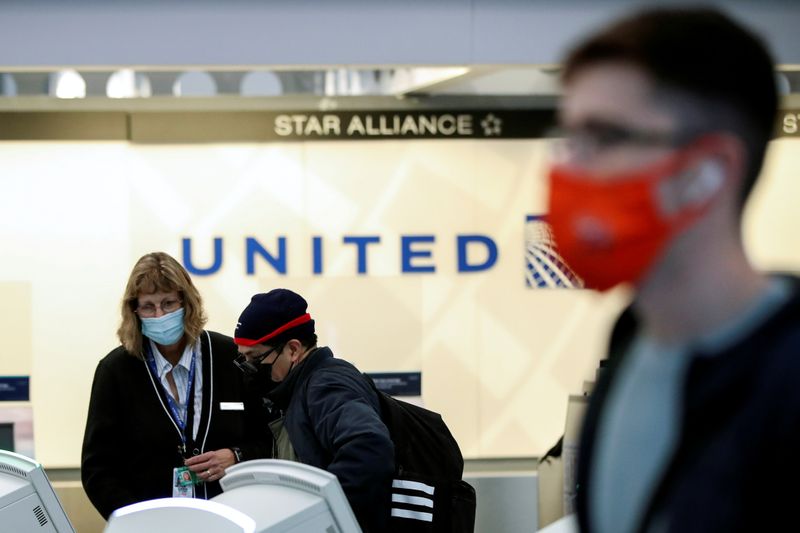This post was originally published on this site
https://i-invdn-com.akamaized.net/trkd-images/LYNXMPEGBA0OV_L.jpg
CHICAGO (Reuters) – United Airlines is telling some flight attendants whose colleagues test positive for COVID-19 to keep flying and monitor for symptoms, three employees told Reuters, raising concerns among staff about the policy.
“Most of us feel that’s unsafe,” said one of the employees. Reuters also viewed around a dozen comments in a private online group for United flight attendants, which expressed unease and frustration about loose quarantine and contract tracing protocols by the airline.
United’s major rival American Airlines (NASDAQ:AAL), by contrast, removes all crew from service when they have worked with an infected person, a policy decision American flight attendants and the union representing them affirmed.
The Federal Aviation Administration (FAA) has issued COVID-19 policy recommendations but there are no government mandates on the topic. That has created inconsistent safety protocols across the industry, from how an airplane is boarded and blocking middle seats to inflight service and crew quarantines, unions said.
The Association of Flight Attendants-CWA (AFA), which represents crew at 17 airlines including United, said that it has received complaints from members about United not isolating all crew who have worked with an infected colleague.
“We’ve received concerns about quarantine protocols from flight attendants across the industry from carriers we represent and where we’re organizing,” said AFA spokeswoman Taylor Garland, who added some complaints were from flight attendants at Delta Air Lines (NYSE:DAL).
Asked about its policy and flight attendants’ concerns, United did not dispute that it tells some to self-monitor and continue working after a colleague tests positive for COVID-19, saying it follows Centers for Disease Control and Prevention (CDC) guidance on quarantines for “close contacts.”
The CDC defines close contact as being within 6 feet (1.83 m) of an infected person for a cumulative total of 15 minutes or more over 24 hours starting from two days before the onset of illness until isolation.
“If a flight attendant or pilot meets the criteria, we ask them to quarantine. If not, they are instructed to self-monitor,” United spokeswoman Leslie Scott said. She declined to explain how it determines a close contact.
Delta spokesman Morgan Durrant said: “As we have throughout this pandemic, we follow guidelines from the CDC and other health authorities to ensure that all Delta people quarantine if they have prolonged, close contact with a Covid-19 positive individual.”
United and Delta both said the safety and health of their customers and employees is their top priority and noted measures to combat the spread of COVID-19, including requiring masks and deeper cleaning.
Airlines say studies show that airplanes are “uniquely safe” thanks to hospital-grade air filtration systems, assuming people wear masks, and that flight crews have not contracted COVID-19 at higher rates than the rest of the U.S. population.
But as cases spike across the country, they are increasing among airline workers too.
AFA said it saw an average of 50 positive COVID-19 tests a week in November among roughly 25,000 active crew, up from about 10 weekly in the summer.
For an interactive graphic tracking the global spread of COVID-19, open https://graphics.reuters.com/world-coronavirus-tracker-and-maps/ in an external browser.
POTENTIAL EXPOSURE
The seeming discrepancy in quarantine protocols comes amid strained staffing after mass furloughs and as some airlines resume food and beverage service.
Flight attendants said they work closely even if they are assigned to different galleys and share several legs of a domestic shift and layovers.
Asked for details on its quarantine criteria, United said it follows the FAA’s bulletin, the Safety Alert for Operators.
The Nov. 4 bulletin on quarantines says the FAA and CDC recommend that crew members with known exposure to COVID-19 not work until 14 days after the last potential exposure.
It also cites CDC guidance that even if crew members show no symptoms, they should not be allowed to work since they cannot remove themselves if they develop symptoms.
It notes “the challenges involved in effectively isolating a symptomatic person on board an aircraft.”
Last week the CDC shortened the quarantine to seven days with a negative test and 10 without a test.
United’s Scott said the airline was following the new guidance on the number of days close contacts should quarantine while the FAA works on updating the bulletin.
The union, however, has asked the FAA to maintain or strengthen the recommendation that any flight attendant potentially exposed to the virus quarantine for 14 days.
“With the pandemic worsening as winter approaches, it is unacceptable to backtrack on existing quarantine practices that are critical for limiting infections,” AFA’s director of air safety, Christopher Witkowski, said in a Dec. 5 letter seen by Reuters.
RISING STRAIN
Flight attendants are also worried about decisions by airlines including United to resume food and beverage service, which they say encourages people to remove masks.
Hot drinks are of particular concern because of blowing.
AFA has asked airlines to minimize onboard service and only serve cold food and drinks on shorter flights.
United encourages passengers to “keep it brief and replace their mask” when they are not eating or drinking, United’s Scott said, and noted that United runs its air filtration systems from boarding to deplaning.
Between voluntary and involuntary departures, Chicago-based United has 60% fewer flight attendants than before the pandemic.
Staffing strains were evident last month when United’s senior vice president of inflight services, John Slater, mentioned an “excessive” number of late sick calls by flight attendants in a memo to staff seen by Reuters. Slater said the late sick calls caused hundreds of missed connections.
The president of AFA’s United chapter, Ken Diaz, hit back, saying: “The headache or aches and pains that we once came to work with are today indicators of a COVID-19 infection. And, try as we might to control when these symptoms appear, we’re simply not able to do so.”

